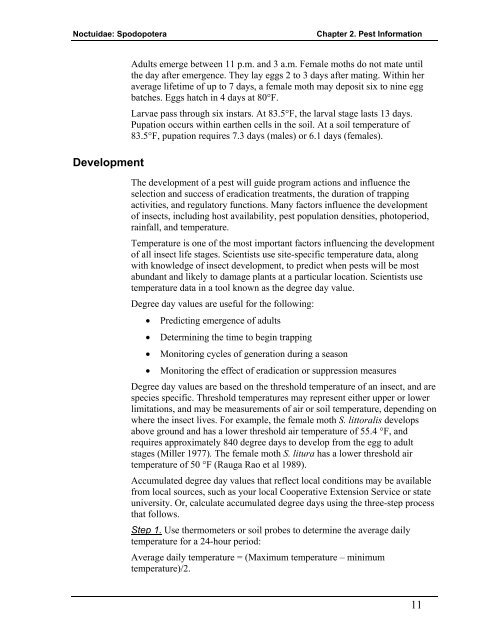New Pest Response Guidelines - Phytosanitary Resources
New Pest Response Guidelines - Phytosanitary Resources
New Pest Response Guidelines - Phytosanitary Resources
Create successful ePaper yourself
Turn your PDF publications into a flip-book with our unique Google optimized e-Paper software.
Noctuidae: Spodopotera<br />
Chapter 2. <strong>Pest</strong> Information<br />
Development<br />
Adults emerge between 11 p.m. and 3 a.m. Female moths do not mate until<br />
the day after emergence. They lay eggs 2 to 3 days after mating. Within her<br />
average lifetime of up to 7 days, a female moth may deposit six to nine egg<br />
batches. Eggs hatch in 4 days at 80°F.<br />
Larvae pass through six instars. At 83.5°F, the larval stage lasts 13 days.<br />
Pupation occurs within earthen cells in the soil. At a soil temperature of<br />
83.5°F, pupation requires 7.3 days (males) or 6.1 days (females).<br />
The development of a pest will guide program actions and influence the<br />
selection and success of eradication treatments, the duration of trapping<br />
activities, and regulatory functions. Many factors influence the development<br />
of insects, including host availability, pest population densities, photoperiod,<br />
rainfall, and temperature.<br />
Temperature is one of the most important factors influencing the development<br />
of all insect life stages. Scientists use site-specific temperature data, along<br />
with knowledge of insect development, to predict when pests will be most<br />
abundant and likely to damage plants at a particular location. Scientists use<br />
temperature data in a tool known as the degree day value.<br />
Degree day values are useful for the following:<br />
• Predicting emergence of adults<br />
• Determining the time to begin trapping<br />
• Monitoring cycles of generation during a season<br />
• Monitoring the effect of eradication or suppression measures<br />
Degree day values are based on the threshold temperature of an insect, and are<br />
species specific. Threshold temperatures may represent either upper or lower<br />
limitations, and may be measurements of air or soil temperature, depending on<br />
where the insect lives. For example, the female moth S. littoralis develops<br />
above ground and has a lower threshold air temperature of 55.4 °F, and<br />
requires approximately 840 degree days to develop from the egg to adult<br />
stages (Miller 1977). The female moth S. litura has a lower threshold air<br />
temperature of 50 °F (Rauga Rao et al 1989).<br />
Accumulated degree day values that reflect local conditions may be available<br />
from local sources, such as your local Cooperative Extension Service or state<br />
university. Or, calculate accumulated degree days using the three-step process<br />
that follows.<br />
Step 1. Use thermometers or soil probes to determine the average daily<br />
temperature for a 24-hour period:<br />
Average daily temperature = (Maximum temperature – minimum<br />
temperature)/2.<br />
11













